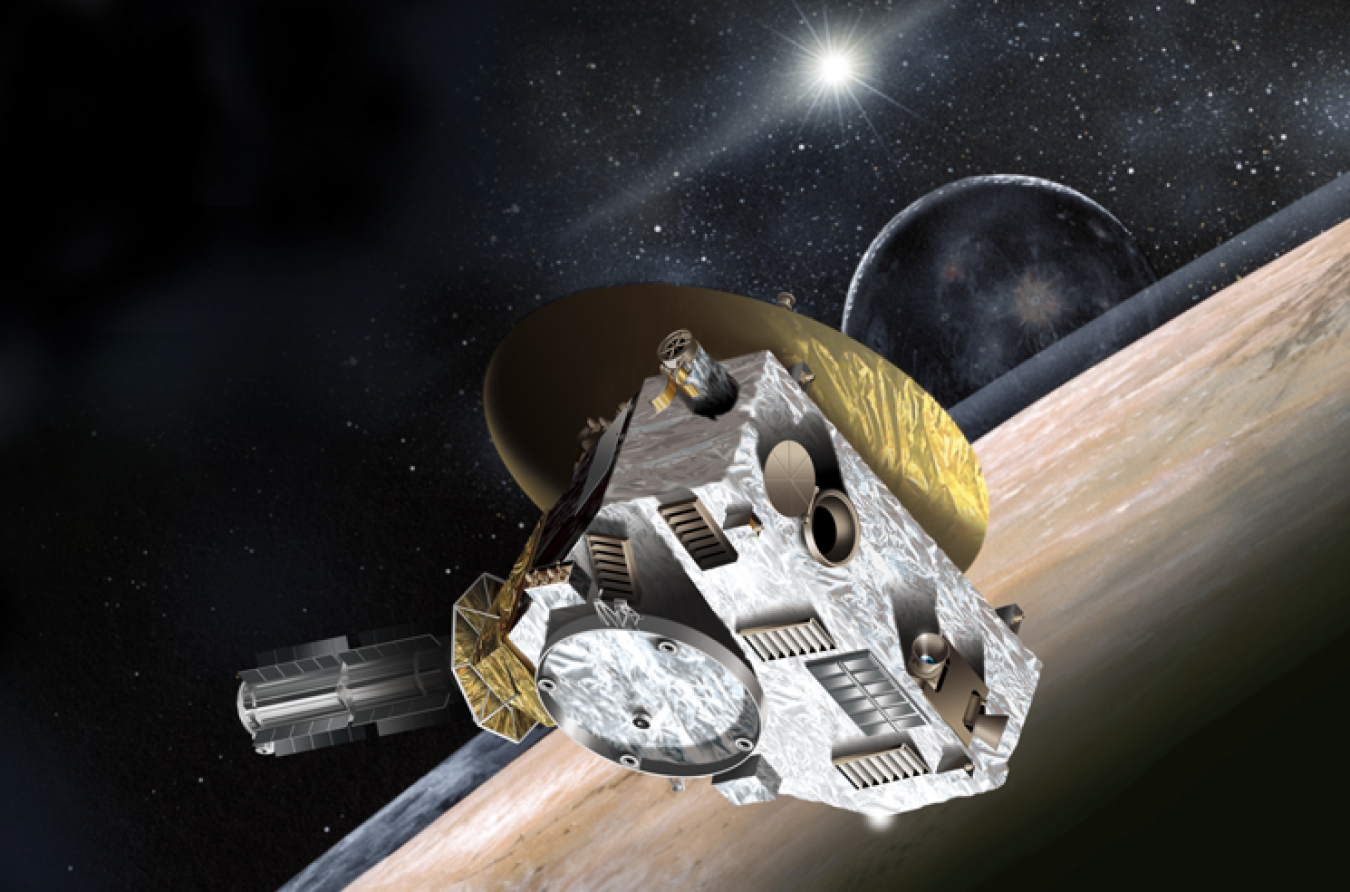
Artist's concept of the New Horizons spacecraft. The craft's miniature cameras, radio science experiment, ultraviolet and infrared spectrometers and space plasma experiments are run by DOE's Radioisotope Thermoelectric Generator.
In January 2006, the New Horizons Project sent a spacecraft on a mission to fly by the Pluto-Charon system and encounter up to three Kuiper Belt Objects (KBOs). The mission trajectory swung by Jupiter. While the mission’s main objective is to gather and return data on Pluto-Charon, science data would also be obtained on Jupiter and some of its moons and on the as-yet undetermined KBOs. This data would be used by the international science community to better understand the formation and history of the outer solar system.
The New Horizons spacecraft utilized a Radioisotope Thermoelectric Generator (RTG) to provide electricity and heat to the science instruments and other spacecraft components.
Why are Radioisotope Thermoelectric Generators Needed in Space?
Most Earth orbital spacecraft use solar panels to convert solar energy into electrical power. Because Pluto is nearly four billion miles from the sun, more than 30 times farther away than earth, solar radiation intensity is extremely low. As a result, solar panels would have to be excessive in size -- too massive for existing launch vehicles. Similarly, existing batteries and chemical power sources cannot provide power for the length of time required by the Pluto mission.
What is the History of RTGs in Space?
RTGs are not a new part of the U.S. space program. In fact, they have enabled the National Aeronautics and Space Administration (NASA) to explore the Solar System for many years. The Apollo missions (to the Moon), the Viking missions (to Mars), and the Pioneer, Voyager, Ulysses, Galileo, and Cassini (outer Solar System) missions all used RTGs. The RTGs for the Pioneer 10 spacecraft have operated flawlessly for three decades and continue to power the spacecraft as it continues into interstellar space. Over the last three decades, the United States has launched 25 missions involving 44 RTGs. While RTGs have never been the cause of a spacecraft accident, they have been on board three space missions that did fail for other reasons. In all three cases, the RTGs performed as designed. Early RTGs carried smaller amounts of radioisotope material and in keeping with the safety philosophy at the time, were built to burn up at high altitude during an accidental reentry. One such reentry occurred in 1964 during the malfunction of a navigational satellite for the Navy. Later RTGs were designed to contain their plutonium in case of reentry and performed this function successfully in mission failures in 1968 (a weather satellite launch failure) and 1970 (Apollo 13).
How Do RTGs Work?
The New Horizon RTG consists of two major elements: a heat source that contains the plutonium-238 dioxide fuel and a set of solid-state thermocouples that convert the plutonium’s heat energy into electricity.
Conversion of heat directly into electricity is not a new principle. It was discovered 150 years ago by a German scientist named Thomas Johann Seebeck. He observed that an electric voltage is produced when two dissimilar, electrically conductive materials are joined in a closed circuit and the two junctions are kept at different temperatures.
Such pairs of junctions are called thermoelectric couples, or thermocouples. The power output is a function of the temperature of each junction and thermoelectric materials properties. The thermocouples in RTGs use heat from the radioactive decay of plutonium to heat the hot junction of the thermocouple, and the cold of outer space to produce a low temperature at the cold junction of the thermocouple.
The heat source for an RTG is composed of 72 specially contained ceramic pellets of plutonium-238 dioxide. The pellets weigh a total of about 24 pounds (11 kilograms). The RTG will produce about 213 watts of electricity, at the beginning of the mission in January 2006.
Safety Design
RTGs are designed and tested to contain their radioactive fuel during all normal and accident conditions.
The RTG is composed of 18 modules. Each module contains 4 plutonium dioxide fuel elements enclosed within several layers of protective materials. The purpose of these multiple protective layers is to minimize the effect of the physical conditions that might result from an accident and to reduce or prevent the release of plutonium fuel into the environment.
The plutonium fuel used in the RTG is a ceramic, oxide form, similar in nature to ceramics used in kitchenware. It is insoluble in water and chemically nonreactive. This means that if released into the environment, the plutonium migrates very slowly into the food chain. Then it hits hard surfaces, it breaks into relatively large pieces rather than crumbling into dust; consequently, potential inhalation of very small particles is minimized. The plutonium pellets are surrounded by a metal alloy of iridium capable of withstanding very high temperatures. This cladding protects against reentry heating and other accident scenarios.
The other protective layers are made of a special graphite composite material with an extremely high temperature resistance. This material is ;used by the Air Force to protect missile nose cones and is on of the best available for reentry applications. A three- quarter inch thick layer of metal and fiberglass insulation surrounds the modules and provides an additional protective barrier. The entire assembly is then enclosed in an aluminum outer shell.
Summary
Extensive safety tests conducted by the Department of Energy demonstrated that the RTGs are rugged and can withstand all but the most extreme and unlikely accident conditions. Because they are also light weight and highly reliable power sources, the RTG is uniquely suited to meet the needs of the New Horizons mission.
